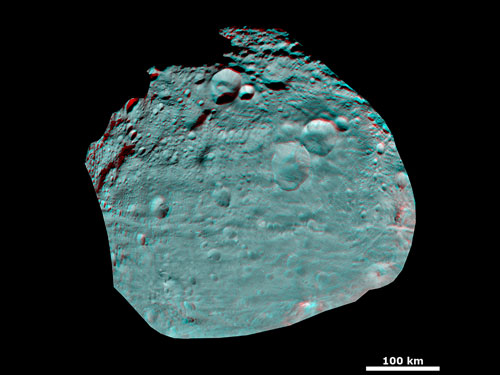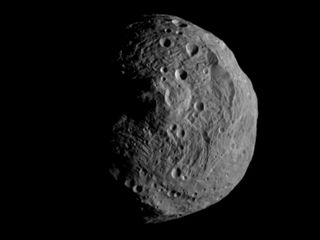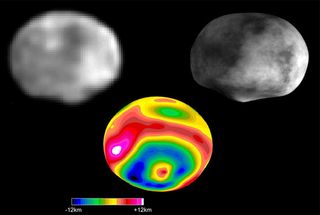Vesta: Facts About the Brightest Asteroid

Vesta is the second most massive body in the asteroid belt, surpassed only by Ceres, which is classified as a dwarf planet. The brightest asteroid in the sky, Vesta is occasionally visible from Earth with the naked eye. It is the first of the four largest asteroids (Ceres, Vesta, Pallas and Hygiea) to be visited by a spacecraft. The Dawn mission orbited Vesta in 2011, providing new insights into this rocky world.
Celestial Police
In 1596, while determining the elliptical shape of planetary orbits, Johannes Kepler came to believe that a planet should exist in the gap between Mars and Jupiter. Mathematical calculations by Johann Daniel Titius and Johann Elert Bode in 1772 — later known as the Titius-Bode law — seemed to support this prediction. In August 1798, a group known as the Celestial Police formed to search for this missing planet. Among these was German astronomer Heinrich Olbers. Olbers discovered the second known asteroid, Pallas. In a letter to a fellow astronomer, he put forth the first theory of asteroid origin. He wrote, "Could it be that Ceres and Pallas are just a pair of fragments … of a once greater planet which at one time occupied its proper place between Mars and Jupiter?"
Olbers reasoned that the fragments of such a planet would intersect at the point of the explosion, and again in the orbit directly opposite. He observed these two areas nightly, and on March 29, 1807, discovered Vesta, becoming the first person to discover two asteroids. After measuring several nights' worth of observations, Olbers sent his calculations to mathematician Carl Friedrich Gauss, who remarkably computed the orbit of Pallas in only 10 hours. As such, he was given the honor of naming the new body. He chose the name Vesta, goddess of the hearth, and sister to Ceres. [Photos: Asteroid Vesta and NASA's Dawn Spacecraft]

Physical characteristics of Vesta
Vesta is unique among asteroids in that it has light and dark patches on the surface, much like the moon. Ground-based observations determined that the asteroid has basaltic regions, meaning that lava once flowed across its surface. It has an irregular shape, roughly that of an oblate spheroid (in nontechnical terms, a somewhat smooshed sphere).
- Diameter: 329 miles (530 kilometers)
- Mass: 5.886 X 1020 lbs. (2.67 x 1020 kilograms)
- Temperature: 85 to 255 K (minus 306 to 0 degrees Fahrenheit / minus 188 to minus 18 degrees Celsius)
- Albedo: 0.4322
- Rotation period: 5.342 hours
- Orbital period: 3.63 years
- Eccentricity: .0886
- Aphelion: 2.57 AU
- Perihelion: 2.15 AU
- Closest approach to Earth: 1.14 AU
Surface, composition and formation
When Vesta made a close approach to Earth in 1996, the Hubble Space Telescope mapped its topographic surface and features. This revealed a large crater at the south pole that slices into its interior. The crater averages 460 km in diameter — remember: Vesta itself is only 530 km across. It cuts an average of 13 km into the crust, and most likely formed from an impact in the asteroid's early life. The material ejected from this collision resulted in a number of smaller — Vestoid — asteroids that orbit near their parent, as well as some of the meteorites that have crashed into Earth.
Unlike most asteroids, the interior of Vesta is differentiated. Like the terrestrial planets, the asteroid has a crust of cooled lava covering a rocky mantle and an iron and nickel core. This lends credence to the argument for naming Vesta as a protoplanet, rather than as an asteroid.
Vesta's core accreted rapidly within the first 10 million years after the formation of the solar system. The basaltic crust of Vesta also formed quickly, over the course of a few million years. Volcanic eruptions on the surface stemmed from the mantle, lasting anywhere from 8 to 60 hours. The lava flows themselves ranged from a few hundred meters to several kilometers, with a thickness between 5 to 20 meters. The lava itself cooled rapidly, only to be buried again by more lava until the crust was complete. Dawn's gravity put its core at about 18 percent of Vesta's mass, or proportionally about two-thirds as massive as Earth's core.
In fact, if it weren't for Jupiter, Vesta could have had a good chance at becoming a planet.
"In the asteroid belt, Jupiter basically stirred things up so much that they weren't able to easily accrete with one another," Dawn scientist David O'Brien, of the Planetary Science Institute in Tucson, Arizona, told reporters in 2012.
"The velocities in the asteroid belt were really high, and the higher the velocity is, the harder it is for things to merge together under their own gravity," O'Brien added.
In 1960, a fireball streaking through the sky over Millbillillie, Australia, announced the arrival of a piece of Vesta on Earth. Composed almost entirely of pyroxene, a mineral found in lava flows, the meteorite bears the same spectral signals as Vesta.
NASA's Dawn spacecraft, which visited the asteroid in 2012, discovered that the rocky body had a surprising amount of hydrogen on its surface. It also found bright, reflective regions that may have been left over from its birth.
"Our analysis finds this bright material originates from Vesta and has undergone little change since the formation of Vesta over 4 billion years ago," said Jian-Yang Li, a Dawn participating scientist at the University of Maryland, College Park, in a statement.
A massive mountain towers over Vesta's southern pole. The enormous mountain reaches up over 65,000 feet (20 kilometers) in height, making it nearly as tall as Olympus Mons, the largest mountain (and volcano) in the solar system. Olympus Mons soars about 15 miles (24 kilometers) above the surface of Mars.
"The south polar mountain is larger than the big island of Hawaii, the largest mountain on Earth, as measured from the ocean floor," Dawn principle investigator Chris Russell was reported saying at a 2011 astronomical conference. "It is almost as high as the highest mountain in the solar system, the shield volcano Olympus Mons on Mars."
Liquid water once flowed across the asteroid. Images captured by the Dawn spacecraft revealed curved gullies and fan-shaped deposits within eight different Vesta impact craters. All eight of the craters are thought to have formed within the last few hundred million years, fairly recent in the lifetime of the 4.5-billion-year-old asteroid.
"Nobody expected to find evidence of water on Vesta. The surface is very cold and there is no atmosphere, so any water on the surface evaporates," study lead author Jennifer Scully, a postgraduate researcher at UCLA, said in a NASA statement. "However, Vesta is proving to be a very interesting and complex planetary body."
Scully and her team thought the features were created by debris flows, as opposed to pure-water rivers or streams, sculpted the Vesta gullies. They proposed that meteorites bombarding the asteroid melted ice deposits beneath the surface, sending liquid water and small rocky particles flowing down the crater walls. Such activity suggests the presence of ice buried beneath the surface.
"If present today, the ice would be buried too deeply to be detected by any of Dawn's instruments," Scully said. "However, the craters with curved gullies are associated with pitted terrain, which has been independently suggested as evidence for loss of volatile gases from Vesta."
Ice could have been responsible for modifying Vesta's surface. In 2017, a study suggested that smooth patches of terrain on the asteroid frequently possessed high concentrations of hydrogen, which is often seen when solar radiation breaks down water molecules.
"We suggest that modifications of the surface by melting of buried ice could be responsible for smoothing those areas," Essam Heggy, a planetary scientist at the University of Southern California in Los Angeles, told Space.com. "Buried ice could have been brought to the surface after an impact, which caused heated ice to melt and travel up through the fractures to the surface."
Dawn also observed signs of hydrated minerals (minerals containing water molecules) on Vesta's surface, which could also hint at the presence of buried ice. The hydrated materials were associated with older terrains, and could have been delivered by impacts of material from farther out in the solar system.
A low-altitude map of Vesta revealed a rich geology. The steep slopes found on the asteroid, combined with its high gravity, paves the way for rocks to roll downward, exposing other material. Dawn revealed a variety of mineral, including some bright and dark materials that could relate to potential buried ice.

Vestal visitors to Earth
In fact, Vesta's unique composition means that it is responsible for an entire group of meteorites. The HED meteorites — made up of howardites, eucrites and diogenites — tell the story of Vesta's early life. Eucrites form from hardened lava, while diogenites come from beneath the surface. Howardites are a combination of the two, formed when a large impact mixed the two sections together.
Vesta has been suspected as being the source of the HED meteorites since 1970. Dawn's mapping spectrometer verified that proposition. The Dawn team thinks the HEDs came from an impact basin named Rheasilvia, after an ancient Roman vestal virgin priestess. At 310 miles (500 kilometers) in diameter, Rheasilvia is nearly as large as Vesta itself. It most likely formed from a collision that stripped away most of the southern hemisphere's crust, revealing the asteroid's interior.
"Vesta likely came close to shattering," said Dawn principal investigator Carol Raymond, noting that the blow left concentric sets of troughs — fracture lines — around Vesta's equator.
Parallel troughs may be another sign of the enormous impact. Raymond told the Planetary Society that the presence of those troughs suggests serious damage to the asteroid's interior.
If the orbit of Vesta lies beyond Mars, how did pieces of it manage to arrive on Earth? The fragments of Vesta pass Jupiter once every three orbits around the sun, allowing the gravity of the largest planet to affect them. Such tugging could have shifted the fragments enough to cause their eventual impact with Earth.
As a result, Vesta is one of three bodies from which scientists have samples. The other two are the moon and Mars.
Exploring the asteroid
In September 2007, NASA launched the Dawn mission, which is unique in that it was the first craft to enter orbit around one solar system body, then proceed to a second. Dawn entered orbit around Vesta in July 2011. After studying the asteroid for a year, it left Vesta encountered Ceres in March 2015.
NASA's Dawn mission is to study the characteristics of the early solar system by analyzing the two asteroids, which are very different. Ceres is wet, with seasonal polar caps, and may have a thin atmosphere. Vesta, on the other hand, is dry and rocky. Studying the unique spectral signatures in its rocky crust will expand our knowledge of our own planet, as well as Mars and Mercury.
Given their size, the two are actually regarded as protoplanets, or small planets. The gravitational pull of Jupiter disrupted their formation. Without the presence of the gas giant, the two may well have continued to evolve into full-size planets.
"We now know that Vesta is the only intact, layered planetary building block surviving from the very earliest days of the solar system," Dawn deputy principal investigator Carol Raymond, of NASA's Jet Propulsion Laboratory in Pasadena, California, told reporters in 2012.
Dawn's study of Vesta allowed for the creation of the best map to date of the asteroid.
In October 2010, the Hubble Space Telescope imaged Vesta again. The resulting data revealed that the asteroid was tilted approximately four degrees more than scientists originally thought. These findings helped NASA to place the spacecraft in the appropriate polar orbit around the asteroid. Dawn requires light from the sun in order to perform its mapping and imaging assignments.
Editor's note: This article was updated on May 29, 2018, to clarify that Vesta was not the first asteroid to be visited by a spacecraft, but rather the first of the four largest asteroids to be visited.
Additional resources
- Download this PDF about the discovery of asteroids and the Dawn mission.
- Visit this blog on the JPL website for a 3D view of Vesta.
- What did Dawn learn at Vesta? via The Planetary Society
Follow Nola Taylor Redd at @NolaTRedd, Facebook, or Google+. Follow us at @Spacedotcom, Facebook or Google+.
Join our Space Forums to keep talking space on the latest missions, night sky and more! And if you have a news tip, correction or comment, let us know at: community@space.com.
Get the Space.com Newsletter
Breaking space news, the latest updates on rocket launches, skywatching events and more!

Nola Taylor Tillman is a contributing writer for Space.com. She loves all things space and astronomy-related, and enjoys the opportunity to learn more. She has a Bachelor’s degree in English and Astrophysics from Agnes Scott college and served as an intern at Sky & Telescope magazine. In her free time, she homeschools her four children. Follow her on Twitter at @NolaTRedd